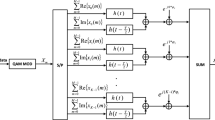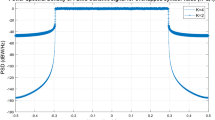Abstract
The demand for more bandwidth is increasing day by day due to explosive growth in data generated on account of services enabled on mobile phone, laptops and IOT devices. In the near future Internet for everything (IoE) technology where social media, processes, big data etc. will require internet connectivity all the times. Filter bank multicarrier with offset quadrature amplitude modulation system (FBMC/OQAM) is one of the promising techniques for next generation wireless communication system (5G). In FBMC-OQAM orthogonality condition is relaxed to obtain, better bandwidth utilization. This FBMC-OQAM is a multi-carrier transmission scheme where sub-carriers are independent to each other in time domain. The composite signal has large variation in amplitude, thus lead to peak to average power variation problem. This paper presents a FBMC scheme based on DFT spread and identically time shifted multicarriers (ITSM) conditions. In the chosen scheme DFT and IDFT is performed once and system behave as a nearly single carrier. This paper also deals with, PAPR reduction scheme. The chosen scheme is based on clipping and non-liner companding scheme, and obtained results are compared with recently proposed method.













Similar content being viewed by others
References
Wulich, D. (2005). Definition of efficient PAPR in OFDM. IEEE Communications Letters,9(9), 832–834.
Sahin, I. G., & Arslan, H. (2014). A survey on multicarrier communications: Prototype filters, lattice structures, and implementation aspects. IEEE Commun Surv Tutor,16(3), 1312–1338.
Schaich, F. (2010). Filterbank based multi carrier transmission (fbmc); evolving ofdm: Fbmc in the context of wimax. In 2010 European Wireless Conference (EW), April 2010, pp. 1051–1058.
FP7-ICT PHYDYAS Project. (2009). Prototype filter and structure optimization, project deliverable D5.1, (section 5.2.3). Retrieved January 22, 2009 from https://www.ict-phydyas.org/delivrables.
Ihalainen, T., Viholainen, A., Stitz, T. H., Renfors, M., & Bellanger, M. (2009). Filter bank based multi-mode multiple access scheme for wireless uplink. In Proceedings European Signal Processing Conference, August 2009, pp. 1354–1358.
Baltar, L. G., Slim, I., & Nossek, J. A. (2015). Efficient filter bank multicarrier realizations for 5G. In Proceedings of IEEE International Symposium Circuits System, May 2015, pp. 2608–2611.
Bulusu, S. S. K. C., Shaiek, H., Roviras, D. (2015). Reduction of PAPR of FBMC-OQAM systems by dispersive tone reservation technique. In Proceeding of International Symposium on Wireless Communication Systems, 25–28 August 2015, Brussels, Belgium. IEEE.
Wang, H., Wang, X., Xu, L., & Du, W. (2016). Hybrid PAPR reduction scheme for FBMC/OQAM systems based on multi data block PTS and TR methods. IEEE Access,4, 4761.
Shi, N. & Wei, S. (2016). A partial transmit sequences based approach for the reduction of peak-to-average power ratio in FBMC system. In Proceedings of 25th wireless and optical communication conference, 21–23 May 2016, Chengdu, China. IEEE.
Ikni, S., Abed, D., Redadaa, S., & Sedraoui, M. (2019). PAPR reduction in FBMC-OQAM systems based on discrete sliding norm transform technique. Radioelectronics and Communications Systems,62(2), 51–60.
Xi, S., Zhong, Z., Liu, Y., Chen, X., Wang, F., & Miao, D. (2016). DFT-spread universal filtered multi-carrier for 5G. In 2016 2nd IEEE International Conference on Computer and Communications (ICCC) (pp. 1591–1596). IEEE.
Na, D., & Choi, K. (2017). Low PAPR FBMC. IEEE Transactions on Wireless Communications,17(1), 182–193.
Nissel, R. & Rupp, M. (2016). On pilot-symbol aided channel estimation in FBMC-OQAM. In IEEE ICASSP.
Kim, C., Yun, Y. H., Kim, K., & Seol, J.-Y. (2016). Introduction to QAM-FBMC: From waveform optimization to system design. IEEE Communications Magazine,54(11), 66–73.
Shaheen, I. A., Zekry, A., Newagy, F., & Ibrahim, R. (2019). Performance evaluation of PAPR reduction in FBMC system using nonlinear companding transform. ICT Express,5(1), 41–46.
Ye, C., Li, Z., Jiang, T., Ni, C., & Qi, Q. (2014). PAPR reduction of OQAM-OFDM signals using segmental PTS scheme with low complexity. IEEE Transactions on Broadcasting,60(1), 141–147.
Author information
Authors and Affiliations
Corresponding author
Additional information
Publisher's Note
Springer Nature remains neutral with regard to jurisdictional claims in published maps and institutional affiliations.
Appendix
Appendix
The impulse response of the pulse shaping prototype filter is denoted by h(t), and K represents the overlapping factor of the pulse.
Using the polyphase decomposition theory, we have
The above filter can be de-composed into N elementary filters,
The term \(\left[ {\sum\nolimits_{k = 0}^{K - 1} {h\left[ {kN + n} \right]z^{ - kN} } } \right]\) is known as polyphase component of H(z), once prototype filter is designed then using frequency shifting filter bank can be designed (Fig. 14).
The transfer function of the mth filter can be written as
where \(W = e^{ - j2\pi /N}\). Thus it performs the frequency de-composition of input signal. In poly phase networks first input data is divided into blocks of size BW, and each carrier is passed through the filter h(t) and multiply by a phase factor. This process is repeated for each sub-carrier in all the block. Due to the various phases applied complete structure is known as poly phase network.
Rights and permissions
About this article
Cite this article
Srivastava, M.K., Shukla, M.K., Srivastava, N. et al. A Hybrid Scheme for Low PAPR in Filter Bank Multi Carrier Modulation. Wireless Pers Commun 113, 1009–1028 (2020). https://doi.org/10.1007/s11277-020-07265-7
Published:
Issue Date:
DOI: https://doi.org/10.1007/s11277-020-07265-7





